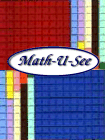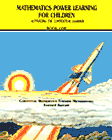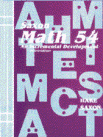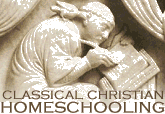Text Only
(Printer-Friendly)
coming soon
Contents
Introduction
Trivium
Grammar
Dialectic
Rhetoric
Homeschool
Curriculum
CCH FAQ
CE Links
Favorite
Reciprocal
What’s New
About CCH
Search CCH
Art History

Classical Christian
Homeschooling:
Classical Education
at Home
WebMaster:
Christine
Miller
CCH’s Online Catalog: Grammar Stage Math - Grades 1-6
This page last revised:
June 2001
Copyright © 1997-2001
|
Option 1: Ray’s Arithmetic
For 1st-6th, 7th, or 8th grades.
Ray’s Arithmetic were the texts used in 19th century America, before its jettison of
the classical tradition in education and the dumbing down of our schools, and because of
its excellent approach, is CCH’s top choice for arithmetic instruction in the grammar
stage.
Option 2: Math-U-See Arithmetic
For 1st-6th grades. Ray’s
Arithmetic were the texts used in 19th century America, before its jettison of the
classical tradition in education and the dumbing down of our schools, and because of its
excellent approach, is CCH’s top choice for Arithmetic instruction in the grammar
stage.
Option 3: Professor B’s Mathematics
For beginning or remedial arithmetic
students and up. Professor B’s unique, non-graded approach to arithmetic
is perfect for older children just beginning formal mathematics study, or those who have
had a bad experience with math in public or private school and are in need of some
relearning and remediation, or those who are math-phobic or who have a failure mentality
about math. It is also perfect for parents who want to teach themselves arithmetic so they
can teach it to their children.
Option 4: Saxon Math
For 3rd-6th grades. My personal
experience with Saxon Math has been less than satisfactory. I would recommend either
Ray’s, Math-U-See, or Professor B’s before recommending Saxon. However, there
are some students and parents who take to Saxon’s incremental approach like a duck to
water. This option is for them.
 Ray’s
Arithmetic Set Ray’s
Arithmetic Set
Joseph Ray, M.D.
For 1st-6th, 7th, or 8th grades. Ray’s Arithmetic were the
texts used in 19th century America, before its jettison of the classical tradition in
education and the dumbing down of our schools. Over 120 million copies were sold in its
heyday. Ray’s teaches arithmetic in its logical progressive order of concrete -
mental - symbolic arithmetic, just as Harvey’s taught grammar in its logical
progressive order of letters (orthography) - words (etymology) - sentences (syntax). Most
early work is done with real objects--blocks, marbles, buttons, etc. Later the work shifts
to mental arithmetic with mental images of concrete objects. Then it proceeds to symbolic
arithmetic, gradually dropping the use of objects and images and proceeding to computation
quickly with digits. In this way the child is led carefully through the three progressive
stages in arithmetic: concrete (manipulative), mental, and symbolic. The Ray’s
Arithmetic Set includes all seven books listed below, plus the Parent-Teacher Guide for
Ray’s Arithmetic by Dr. Ruth Beechick. Again, the suggested grade levels are
just that--suggestions only. Once the material in each text is mastered, the child is
ready to go on to the next text. Children do not have to be held back to conform to
suggested grade level guidelines.
Primary Arithmetic
For 1st and 2nd grade. Primary Arithmetic introduces the four operations along with
counting and other basic skills. This text focuses on the concrete or manipulative stage
of arithmetic development. It will not take two years to complete this text; CCH
recommends proceeding to Intellectual Arithmetic when it has been completed.
Intellectual Arithmetic
For 3rd and 4th grade. Intellectual Arithmetic extends the work in the four operations
into higher numbers, as well as introducing fractions, measurements, ratio, and
percentage. This text focuses on the mental stage of arithmetic development. It will not
take two years to complete this text; CCH recommends proceeding to Practical Arithmetic
when it has been completed.
Practical Arithmetic
For 5th and 6th grade. Practical Arithmetic extends basic arithmetic skills to higher
levels, as well as providing work on factoring, decimals, percentage, ratio, proportion,
powers, roots, and geometry. This text focuses on the symbolic stage of arithmetic
development. CCH recommends proceeding to Higher Arithmetic when Practical Arithmetic has
been completed.
Test Examples in Arithmetic
For use with Practical Arithmetic; containing additional problems on all topics covered in
Practical Arithmetic. The book can be used for additional computation practice in these
topics, or for parents to prepare test material.
Key to Primary, Intellectual, and Practical
Arithmetic
Contains all the answers for all the problems in the Primary, Intellectual, and Practical
Arithmetic texts.
Higher Arithmetic
For 7th and 8th grade, or earlier for those children completing the previous texts prior
to the start of 7th grade. Higher Arithmetic includes philosophical understandings;
principles and properties of numbers; and advanced study of common and decimal fractions,
measurements, ratio, proportion, percentage, powers and roots, series, business math, and
geometry. Students that complete this text will have a greater understanding and ability
in arithmetic than most of today’s high school graduates, and will be well-prepared
for algebra, geometry, and advanced mathematics in the dialectic and rhetoric stages, or
even in college. A knowledge of the arithmetic taught in Ray’s was enough to proceed
to Harvard and other classical colleges in America’s colonial days.
Key to Higher Arithmetic
Contains the answers for all the problems in the Higher Arithmetic text.
Parent-Teacher Guide for Ray’s Arithmetic
By respected educator and homeschooling author Dr. Ruth Beechick. The Guide includes
lesson plans for all the texts, from Primary through Higher Arithmetic, how to adapt the
material for slower or faster students, tests for each Ray’s unit in all the texts,
games and activities to enhance concept teaching, and more.
Ray’s Arithmetic Workbooks
The workbooks are not part of the Ray’s Arithmetic Set. The workbooks are also not
necessary, as plenty of exercises are included in the texts. But they are available for
use with the Primary and Intellectual Arithmetic texts for those who wish to use them. The
above texts and the Parent-Teacher Guide, as well as the workbooks, can be purchased
separately (rather than in one set) by contacting the publisher, Mott Media.
 Math-U-See
Arithmetic Math-U-See
Arithmetic
Steve Demme
The Math-U-See program utilizes systematic review over an extended period
of time, and manipulatives, to establish the link between seeing math and understanding
math in children. The program provides the interlocking, colorful blocks and fraction
overlays to teach math, along with the curriculum to provide the systematic practice and
reinforcement of concepts. The goal of Math-U-See instruction is not only to teach a
student how to do math, but to also simultaneously understand the concepts of math.
Because of its design, this program also provides teaching and practice in the grammatical
work of translation from one type of mathematical representation to another; i.e., 2
blocks and 7 blocks makes 9 blocks, and 2 + 7 = 9. One final note: the suggested grade
levels are just that--suggestions only. Once the material in each course is mastered, the
child is ready to go on to the next course. Children do not have to be held back to
conform to suggested grade level guidelines.
Foundations of
Mathematics
For 1st and 2nd grade. The child who can count to nine and write their numbers is ready
for this stage of the curriculum. Topics range from place value through measurement, and
cover operations through an introduction to multiplication. The teacher’s manual
includes instructions, examples, practice problems, answer keys to the student text, extra
word problems, and tests with answer keys. The student text has four worksheets for each
lesson. You will need: the Foundations lesson by lesson instruction video, teacher’s
manual, and student text, and the manipulatives (they only have to be purchased once for
the entire 6-year curriculum). Also recommended is the Skip Count Tape and Coloring Book,
which helps students learn the math facts, and the fraction overlays. While the initial
cost may seem high, the Foundations series covers two years of instruction, and the
manipulatives, fraction overlays, and skip count tape and coloring book do not need to be
purchased again in subsequent years. 37 lessons. Foundations can also be used in 3rd grade
with children whose formal mathematics instruction has been delayed until after the
mastery of phonics, reading, and penmanship. Take the Foundations Placement Test to see
if your child needs this course or if he ready to move on to Intermediate Mathematics.
Intermediate
Mathematics
For 3rd and 4th grade. The child who has mastered the addition, subtraction, and
multiplication facts, and understands the underlying concepts, is ready for this stage of
the curriculum. The course begins with a review of concepts learned in Foundations, and
proceeds from reading & writing numbers to one million through probability, graphing,
and map reading. Along the way the child learns division, fractions, decimals,
percentages, and more. The teacher’s manual includes instructions, examples, extra
problems, and answer keys. The student text has four worksheets for each lesson. You will
need: the Intermediate lesson by lesson instruction video, teacher’s manual, and
student text, fraction overlays, and the manipulatives. Also recommended is the
Intermediate tests & word problems, and the supplementary blocks for use in this stage
of the math curriculum. 41 lessons. Intermediate Mathematics can also be used in 4th grade
with children whose formal mathematics instruction has been delayed. Take the Intermediate Placement Test to
see if your child needs this course or if he is ready to move on to Advanced Mathematics.
Advanced
Mathematics
For 5th and 6th grade. (Their website says for 7th and 8th grades, but a Math-U-See
representative made it clear to me that this is not because children in 5th and 6th grade
cannot do the work with the proper preparation (the previous Math-U-See courses), but
because most modern math curricula teach these concepts in 7th and 8th grades. The
concepts in Advanced Mathematics are still arithmetic concepts, for the most part,
proper for the grammar stage, allowing children to go on to algebra and geometry in the
dialectic, which is proper for the dialectic stage.) The child who understands and can
perform all the basic operations with whole numbers and fractions is ready for this stage
of the curriculum. Topics range from changing fractions and decimals to percents through
positive and negative numbers and probability. Along the way he learns operations with
polynomials, basic geometry, ratio and proportion, squares and square roots, and more. The
teacher’s manual includes instructions, examples, extra problems, selected solution
pages, and answer keys. The student text has four worksheets for each lesson. You will
need: the Advanced lesson by lesson instruction video, teacher’s manual, and student
text, algebra & decimal inserts, manipulatives, and fraction overlays. Also
recommended is the Advanced tests & word problems. 36 lessons. Advanced Mathematics
can also be used in 5th and 6th grades with children whose formal mathematics instruction
has been delayed. Take the Advanced
Placement Test to see if your child needs this course or if he is ready to move on to
Algebra.
 Professor B’s Mathematics Professor B’s Mathematics
Everard Barrett
For beginning or remedial arithmetic students and up. Professor B
(Everard Barrett) takes the subject material of arithmetic, which in modern public and
private education is traditionally spread over seven to eight years of expensive
textbook/workbook materials and instruction, and presents that material in three texts,
three workbooks, and a charts book. The concepts are presented contextually, as a
developmental flow, like a continuing story. These developmental steps are like the rungs
of a ladder; mastery at previous rungs provides readiness for the next connection.
“Arithmetic can be effectively taught as an upward, progressive climbing of the
ladder without gaps,” rather than as a spiral review (the incremental approach).
Professor B’s texts, Mathematics Power Learning for Children, restructure the
traditionally disconnected, fragmented content of arithmetic and inform parents how to
consistently tell the truth simply in all the operations on the whole numbers,
fractions, and decimals, from basic to advanced levels of skill. This truth-telling
approach to arithmetic stimulates and activates a child’s natural capacities for
mastery of mathematics, reduces mental tension related to math, teaches math as a
contextual story that makes sense, enables rapid and thorough understanding, eliminates
remediation and sole rote learning, and allows sustained mastery of skills.
Texts have 150 to 160 pages each, and are non-consumable; they can be used
for each child in the family as often as needed. The consumable workbooks contain the
student’s practice exercises, and each child should have their own workbook. The
workbooks have 131 to 144 pages each. The charts book -- a single non-consumable book
containing all the charts needed for the concepts introduced in Book One -- contains
detailed instructions for speed practice; counting to one hundred and beyond; doubling
numbers mentally; acquiring strong skills in column addition; and maintaining mastery of
the multiplication facts.
There are three levels in Professor B Mathematics. Your child may go on to
the next level when he has satisfactorially completed each level, regardless of grade.
Professor B Mathematics has been designed to allow children to proceed at their own pace,
whether slow or fast, it matters not. Level One includes the non-consumable text,
Mathematics Power Learning for Children Book One, the consumable Workbook Level One (one
per child), and the non-consumable Chart Book. Level Two includes the non-consumable text,
Mathematics for Power Learning for Children Book Two, and the consumable Workbook Level
Two (one per child). Level Three includes the non-consumable text, Mathematics for Power
Learning for Children Book Three, and the consumable Workbook Level Three (one per child).
Professor B has produced videos which correspond to each of the three levels. These videos
do not contain material that is left out of the texts, but they were produced to help
math-phobic parents learn to teach math to their children. They are not necessary, but
helpful for those that would like the security of a little extra hand-holding. When a
child has completed all three levels he may go on to Algebra, but if he is still in the
grammar stage, CCH recommends going on to Ray’s Higher
Arithmetic to learn business math, powers and roots, and all other higher arithmetic
practice, or Math-U-See’s
Advanced Mathematics (which does not include the business math), before beginning
Algebra.
Professor B’s is excellent for those children who have struggled with
traditional mathematics instruction (90% of the students in America), or are transferring
to homeschooling from public or private school, and are either behind in math, or have
been taught the wacky and confusing new-new math or some other such experimental and
damaging program, or who have already developed a “failure mentality” or phobia
about math. There is no such thing as a student who “can’t do math,” just
as there is no such thing as a student who cannot read or write. There are just students
who have been poorly taught. The best instructional program in any subject is the one that
illuminates the subject and makes it clear for every human being. Professor B’s
Mathematics is such a program. I have found that it is also an excellent program for those
students in the dialectic stage who have done Saxon Math all through their career, who can
do arithmetical computations but who do not understand the *concepts* of arithmetic, which
in turn is keeping them from understanding algebraic concepts. It is not traditionally
structured and there are no grade levels, so an older grammar stage or even dialectic or
rhetoric stage child can begin in Level One (or Two, if math facts have been solidly
mastered) and work his way through the entire program in a summer, if he so desires,
before going on to Algebra. A parent who is terrified of the prospect of teaching her
children math because it was not her strong suit in school can go through the program
herself and finally learn arithmetic without the frustration. Professor B’s
Mathematics may not be for everybody, and it certainly is not a traditional grade 1-6
series, but as a remedial course or for those who have delayed mathematics instruction
until phonics, reading, and handwriting has been firmly established (and that is not a bad
idea, and something I would do if I could begin all over again with my children), it is an
excellent, excellent choice.
 Saxon Math: An Incremental
Development Saxon Math: An Incremental
Development
Stephen Hake and John Saxon
For 3rd-6th grades. The Saxon philosophy of instruction is based
on the concept of incremental development: the introduction of topics in easily
understandable pieces (increments), permitting the assimilation of one facet of a concept
before the next facet is introduced. Both facets are then practiced together until another
is introduced. The incrementalization of topics is combined with continual review, wherein
all previously learned material is reviewed in every lesson for the entire year. Topics
are never dropped but are instead increased in complexity and practiced every day,
providing the time required for concepts to become totally familiar. Familiarization of
topics and skills with constant review allows students to internalize and automate
arithmetic operations, the goal of the grammar stage. A further benefit is that the books
are non-consumable texts: the child does his math by copying the problems out of the book
and solving them on notebook paper. The obvious advantage for families with more than one
child is clear - the materials need only be purchased once.
Math 54.
For 3rd or 4th grade. This text begins at the beginning with arithmetic instruction:
addition, counting patterns, digits, place value, writing both cardinal and ordinal
numbers, and so on through subtraction, adding and subtracting two-and three-digit
numbers, simple word problems, beginning multiplication and division, beginning decimals
and fractions, measurements, and time and money. The home-study kit includes time tests
for facts memorization, an important focus of this year’s curriculum. Continue to use
manipulatives (buttons, pennies, etc. - not included) to reinforce old concepts (sets,
addition) and introduce new ones such as double digit addition or subtraction,
multiplication or decimals. 142 lessons.
Math 65.
For 4th or 5th grade. Reviews numbers, counting sequences, place value, reading and
writing both cardinal and ordinal numbers, addition, subtraction; and emphasizes
memorization of multiplication and division facts, multiplication and division word
problems, number lines, very basic geometry, multiplying and dividing money, adding,
subtracting, multiplying and dividing fractions and decimals, conversions, introduction to
percentage, etc. Continue to use manipulatives as needed to illustrate new concepts. 140
lessons.
Math 76.
For 5th or 6th grade. Reviews operations with numbers, and emphasizes operations with
fractions and decimals, expanded notation, least common multiple and greatest common
denominator, factorization, percentages, ratio and proportion, exponents and squared
numbers and roots, more word problems and geometry, unit conversions, etc. 140 lessons.
Math 87.
For 6th or 7th grade. Reviews all topics in arithmetic, such as operations, word problems,
fractions, factorization, decimals, average, ratio, graphs, proportions, exponents, square
roots, rates, percentages; and explores more thoroughly scientific notation, measures,
variables, order of operations, signed numbers, equations, mean, median, mode, range,
interest, probability, and more word problems and geometry. Math 87 reviews and goes
deeper into most of the concepts covered in Math 76. If 76 was a breeze for your child, 87
could be skipped and the year better spent on Algebra 1/2. If Math 76 required your child
to expend time and effort to grasp the concepts, Math 87 will provide the review and
practice toward automation and internalization. 135 lessons.
Algebra
1/2.
For 6th or 7th grade. This text covers all topics normally taught in prealgebra, as well
as additional topics from geometry and discrete mathematics. Students completing the Saxon
program through Algebra 1/2 should be well-versed in: fractions, decimals, mixed and
signed numbers, base two numbers, arithmetic operations, order of operations, percentages,
proportions, ratio, divisibility, rounding, place value, conversions, scientific notation,
and word problems, as well as geometric concepts of classifiction of polygons and solids,
area and perimeter of planar figures, and volume and surface area of geometric solids. 137
lessons. A Saxon Algebra 1/2 Tutorial is also
available with Escondido Tutorial Service.
My personal opinion of pre-algebra is that it is a waste of a year of math
instruction. Arithmetic is the proper preparation for algebra, and every algebra program
worth its salt contains the instruction included in pre-algebra texts. If a 7th grader is
not ready for algebra, he needs remedial arithmetic instruction, and not pre-algebra.
Please see Professor B’s Mathematics for remedial arithmetic
instruction.
Because of the style of presenting the material, through drill and review
using concrete rather than analytical presentation methods, CCH does not recommended
continuing the Saxon program into the dialectic stage, for Algebra and Geometry, unless
the student is taking Algebra with Escondido Tutorial
Service.
This online catalog is made possible through an association with Amazon.com.
Clicking on the book cover will take you to Amazon’s information page about that
book. You can look at its price, availability, any discounts currently taken for that
title, reviews of the book, and other information, as well as order it if you decide to
purchase the book. You can even place books in your shopping cart and save them for
purchase at a later time. You can continue to add or delete books from your shopping cart
until you are satisfied with your order and ready to purchase. Clicking on your
browser’s “Back” button will bring you back to this catalog.
Sometimes books go out of print, or the publisher runs out of stock. Any
book not available from Amazon.com for any reason can be searched using AddAll.com, a book shopping site which will scan Amazon
as well as Barnes and Noble, Powell’s Books, Book Close Outs and many other new and
used book sites. Be sure to also check BookFinder.com
for out of print book searches.
Still have questions? Ask
me!
 
|


